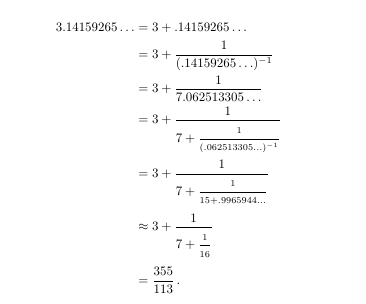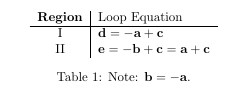
The code for this is:

The code for this is:
\vskip.1inThe only difference in the coding of these two equations is that the second includes the command '\dis', which has the effect of opening up the square roots a bit. This equation was a hack in that, since I knew that I was not going to reference it by the automatic equation numbering system of LaTeX, that I could use a Plain TeX method of displaying an equation and presenting the correct equation number '(i)'.
$\hskip1in X=\root {\textstyle{}n} \of {a+\sqrt{a^2-1}}+\root {\textstyle n} \of {a-\sqrt{a^2-1}}$\,,\hfill(i)
\vskip.1in
\no which, save for a factor of $\half$, is the scalar part of the primary $n$th
\vskip.1in
$\hskip1in X=\dis \root {\textstyle{}n} \of {a+\sqrt{a^2-1}}+\root {\textstyle n} \of {a-\sqrt{a^2-1}}$\,,\hfill(i)
\vskip.1in
\no which, save for a factor of $\half$, is the scalar part of the primary $n$th
If you need to use overarcs, as in the following graphic image

Use the following code:
\begin{equation}
x\equiv \overset{3}{\widearc{4\times5\,a}} + \overset{4}{\widearc{3\times5\,b}}
+ \overset{5}{\widearc{3\times4\,c}} \,,\label{eq:ansatz}
\end{equation}
It uses a combination of the \overset command and the \widearc command. You may need
to apply the package
\usepackage{fourier}
If you want just the arc, don't also use the \overset command. And, as usual,
there are many alternative ways to get arcs over your symbols.
Please see the literature for them.

\begin{equation}
\pm 3\alpha = b - a^2/3\qquad \hbox{and}\qquad \beta = 2a^3/27 - ab/3 + c\,.
\end{equation}

\begin{align}
3.14159265\ldots&=3+.14159265\ldots\notag\\
&=3+\frac{1}{(.14159265\ldots)^{-1}}\notag\\
&=3+\frac{1}{7.062513305\ldots}\notag\\
&=3+ \frac{1}{7+\frac{\strut1}{\strut(.062513305\ldots)^{-1}}}\notag\\
&=3+ \frac{1}{7+\frac{\strut1}{\strut15+.9965944\ldots}}\notag\\
&\approx3+\frac{1}{7+\frac{\strut1}{\strut16}}\notag\\
&= \frac{355}{113}\,.\notag
\end{align}
How to do an overbrace (an underbrace is similar):

The code to this is:
\begin{equation}
\mbox{New Hamiltonian} = (E - p_z)p_z = \underset{\overbrace{\mbox{CM motion}}}{\frac{p_x^2 + p_y^2}{2}} + \frac{M^2}{2}\,.
\end{equation}

\begin{equation}
\binom{n}{k} = \binom{n}{n-k}
\end{equation}

\begin{equation}
\int^\infty_0e^{-x^2}x\pt{}dx=-\half\int^\infty_0e^{-x^2}\pt{}d(-x^2)
=-\half{}e^{-x^2}\Big|^\infty_0=\half\,.
\end{equation}

The code to this is:
\begin{equation}
\iint{}f(x,y)\pt{}dx\pt{}dy=\iint{}f(r)r\pt{}dr\pt{}d\theta
=2\pi\int{}f(r)r\pt{}dr\,.
\end{equation}
Next,

The code to this is:
\begin{equation}
f(a)=\frac{1}{2\pi{}i}\oint_{\cal C}\frac{f(z)}{z-a}\,dz
\end{equation}

The code to this is:
\begin{table}[h!]
\begin{center}
\label{tab:table1}
\begin{tabular}{c|l}
\textbf{Region} & \text{Loop Equation}\\
\hline
I & $\bd = -\ba+\bc$\\
II & $\be = -\bb+\bc= \ba+\bc$\\
\end{tabular}
\caption{Note: $\bb=-\ba$.}
\end{center}
\end{table}

The code to this is:
\begin{align}
\text{(Region I)\quad}\bx &= \bb + \lambda\bc\label{eq:x=blambda}\\
\text{(Region II)\quad} \by &= -\lambda\bc + \bb + 2\ba\label{eq:y=c-a}\\
\text{(Region III)\quad} \by &= -\bc - \ba\qquad \label{eq:y=-c-a}\\
\text{(Region IV)\quad} 3\ba &= -\bb +(\lambda+1)\bc \label{eq:3b=-b..}\\
\text{(Region V)\quad} \by &= 2\bb + 2\ba\label{eq:y=2b+2a}
\end{align}

The code to this is:
\no{}According to Campbell (1921; reprinted 1953, 1):I made the font definition
\vskip.1in
\begin{quote} {\ninerm{}There are two aspects of science. First,
science is a body of useful and practical knowledge and a method of obtaining
it....In its second form or aspect, science has nothing to do with practical
life and cannot affect it, except in the most indirect manner, either for good
or ill. Science of this form is a pure study.} \end{quote}
\font\ninerm=cmr9where cmr9 is Computer Modern Roman 9 point.

The code to this is:
\begin{equation}
\text{HC$_2$H$_3$O$_2$} \rightleftharpoons \text{ H$^+$ + C$_2$H$_3$O$_2{}^-$}\,,
\end{equation}

The code to this is:
\begin{align} [\text{HC$_2$H$_3$O$_2$}]_\text{Before} &= [\text{HC$_2$H$_3$O$_2$}]_\text{After} + [\text{ C$_2$H$_3$O$_2{}^-$}]_\text{After}\notag\\I use the hskips to make my own eyeball alignments.
\text{Molarity:} \hskip.43in 0.50\hskip.43in &= \hskip.2in (0.50-x)\hskip.142in +\hskip.15in\hskip.243in x\,, \label{eq:acetatebeforeafter3.1}
\end{align}

The code to this is:
\begin{equation}
y = R_1 Q_1 = \Big(\frac{1}{210.5}\, \frac{\text{page}}{\text{\cancel{word}}}\Big) (185\text{ \cancel{words}}) = 0.879 \text{ page}\,.
\end{equation}
To be able to use the strike-out feature, employ the package \usepackage{cancel}.

The code to this is:
\begin{verbatim}
solve[T,1=\frac{1}{10}(T)+\frac{1}{15}(T-1)-\frac{1}{20}(T-2)]
\end{verbatim}
The problem arises in HTML of how to display raw HTML in a browser when the browser wants to use it as markup. A similar problem arises in TeX. How do you display raw TeX without the complier treating it as markup instructions? The solution in TeX is to use the verbatim environment. I have yet to find a good way to do this in HTML.

The code to this is:
\texttt{
\begin{itemize}
\setlength{\itemsep}{-2pt}
\item lean beef\ \ -- 20\% protein, 67\% moisture, 13\% fat
\item pork belly -- 10\% protein, 40\% moisture, 50\% fat
\item soy\ \ \ \ \ \ \ \ -- 90\% protein,\ \ 7\% moisture, \ 3\% fat
\end{itemize}
}
The command \texttt renders in typewriter font. Typewriter font gives monospacing or equal-spacing (width) of all the characters, thus making it easier to vertically align characters, especially for tabular use. The command '\ ' places a space on the line.

The code to this is:
\begin{equation}
A':B':C':D' \quad \longleftrightarrow\quad 16:28:8:88\,,
\end{equation}

The code to this is:
\begin{equation}
that if $a,b\in \bbZ\backslash \{0\}$
\end{equation}
where \bbz has been defined as \newcommand{\bbZ}{{\mathbb Z\hskip1pt}}. By the way, the 'bb' stands for 'blackboard bold'.